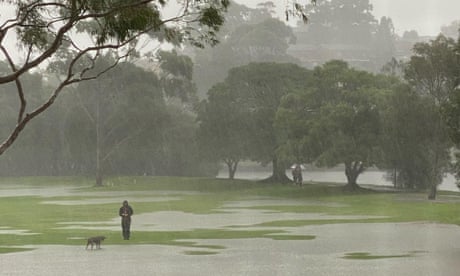- by foxnews
- 08 Apr 2025
Australia’s wettest towns including the Sydney golf course that has recorded 213% of its average yearly rainfall
Australia’s wettest towns including the Sydney golf course that has recorded 213% of its average yearly rainfall
- by theguardian
- 02 Nov 2022
- in news

It's been a miserable year for golf in inner-western Sydney. So much so, the punters at the Marrickville golf club have joked they may as well strike a deal with Sea World and put shark cages on the greens.
With two months to go until the end of the year, the Marrickville course has received more than double its annual average rainfall - placing it among six Sydney locations in the country's Top 10 for above-average falls.
Marrickville groundskeeper Wayne "Rocky" Beckhaus is not surprised. By 25 October, the Bureau of Meteorology had recorded 2,154mm of rain in the club's gauge - 213.1% of its annual mean of 1,010.8mm.
Now 63, Beckhaus lives in the club's cottage after growing up playing the course and tending its greens most his working life. His dad, Merv, 88, still regularly plays there.
"In all the years I've been here, I've never seen it like this," he says. "I've seen floods, OK, the river's broken its banks, sure, but I've never seen it this way."
The club's general manager, Michelle Vernon, says the exceptionally heavy and prolonged rains came on the back of Covid-19 lockdowns and had seen the club wargaming "potential worst case scenarios".
"It's been a struggle," she says.
The struggle is not confined to Sydney golf clubs.
The gauges recording the most rain are largely found in the rainforests of tropical north Queensland and in the northern rivers and border regions in New South Wales.
The gauge atop Bellenden Ker - south of Cairns - is officially the wettest place in Australia, with 7,255mm recorded so far this year, followed by Upper Springbrook on the Gold Coast hinterland, with 5,425mm.
However, a dark blue splodge on the BoM's rainfall deciles map for the year to date shows much of south-east Queensland and north-east New South Wales has experienced its highest recorded rainfall, with dark blue spots extending down the coast past Sydney.
But the No 1 on the list for above-average rainfall was a town 650km west of Sydney.
Wendy Aves runs the service station and caravan park at Ivanhoe. Speaking as flood waters isolated the town of about 260 people from the outside world, she described recent years as "strange".
"We used to be run off our feet," Aves says.
Now 61, Aves, who was born and bred in Ivanhoe, has "seen a lot of things".
"We've had a few floods yeah, but gee, I don't think I've seen this much water," she says.
By 24 October, Ivanhoe had recorded 672mm of rain, compared with an average of 263.5mm.
That meant the town had already received 255% of its annual rainfall, based on 95 years of records, making it the wettest location in Australia compared to what it would normally expect.
Of that list, nine of the Top 10 places were in NSW.
Second was the outback South Australian town of Marree, which has an annual average of just 151.1mm of rain based on 114 years of records. By 23 October, its Witchelina station gauge had recorded 360.2mm, 238.4% of its annual average.
Darkes Forest, between Sydney and Wollongong, received 3,304mm by 25 October; at 233.1% of its annual average it was the third highest in the country.
Sites in and around Sydney - Lucas Heights, Bankstown, Camden, Marrickville, Randwick and Bringelly - filled the slots between four and nine on the list, while Broken Hill airport rounded out the Top 10.
- by foxnews
- descember 09, 2016
Ancient settlement reveals remains of 1,800-year-old dog, baffling experts: 'Preserved quite well'
Archaeologists have recently unearthed the remarkably well-preserved remains of a dog from ancient Rome, shedding light on the widespread practice of ritual sacrifice in antiquity.
read more


